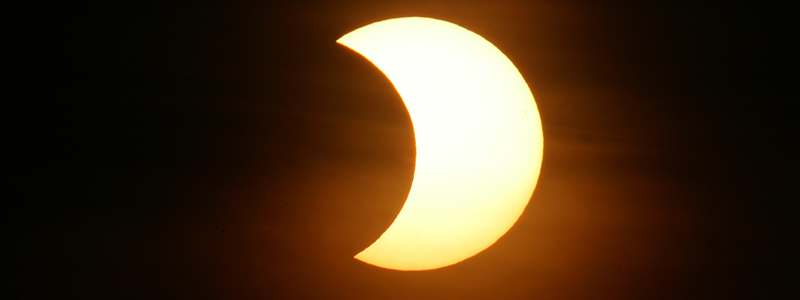Direct viewing of a full or partial solar eclipse can cause permanent eye damage. ARPANSA recommends against direct viewing of a solar eclipse.
Solar eclipses
A solar eclipse occurs when the moon passes between the sun and the earth, casting a shadow on the earth. Solar eclipses occur only over a narrow band of the earth at a time, last only a short time, and are quite rare events. A solar eclipse may be classified as total, annular, or partial, depending on how much of the sun is obscured.
It is extremely dangerous for your eyesight to look directly at the sun at any time, even during a solar eclipse. You should never attempt to observe a total, partial or annular eclipse with the naked eye.
Annular Eclipse
Total eclipse when moon is nearer earth (and appears smaller than the sun), central part of sun obscured, outer ring (or annulus) still visible.

Total eclipse
The entire disc of sun obscured by moon (moon is nearer earth and appears larger than sun).

Partial eclipse
The moon covers only a portion of the sun.

The sun and eye damage
The sun is so intensely bright that it is difficult and very dangerous to look at directly. Looking at the intense light from the sun even for just a few seconds can cause permanent damage to the retina (part of the eye directly responsible for vision). Exposing your eyes to the sun without proper eye protection during a solar eclipse can cause retinal burns (solar retinopathy).
The retina has no sensitivity to pain, and since the effects of retinal damage may not appear for hours, there is no warning that an injury to your eye has occurred. The damage can be temporary or permanent and can cause symptoms such as loss of vision, distorted vision or altered colour vision. The amount of time looking at the sun that will cause eye damage varies between individuals, but in all cases is only a matter of seconds.
During a total solar eclipse, so much of the sun is covered that a person may be tempted to stare at it directly. It is possible to suffer serious and permanent eye damage by looking at any type of solar eclipse and there is no treatment to restore lost vision. Children are especially at risk, as young eyes transmit more light through to the retina than adult eyes. This makes children’s eyes more susceptible to damage from intense light.
Never look at the sun directly using optical aids such as telescopes, binoculars, or cameras — even if you are wearing eclipse glasses. Without properly installed specialist solar filters, viewing the sun through such optical devices will result in immediate and severe eye damage.
Viewing methods
The safest techniques for viewing a solar eclipse are indirect viewing methods. For example, you can view live streams on TV or online, or you can easily project an image of the sun onto a screen using a pinhole projection technique.
Pinhole projections
While facing away from the sun, use a piece of card with a small (~1 mm diameter) hole in the centre to cast a shadow onto a white card or screen ~1 m further away. An inverted image of the eclipse can be viewed on the screen. Remember, do not view the eclipse directly, keep facing away from the sun and only observe the eclipse as the image on the card or screen.

Eclipse sunglasses
Eclipse glasses can allow safe viewing of an eclipse if they meet the requirements of Australian Standard ISO 12312-2 Eye and face protection – Sunglasses and related eyewear Part 2: Filters for direct observation of the sun.
They should also be:
- in good condition
- properly fitted
- used correctly
- free from any defects, such as scratches, punctures, or other damage.
You must also put them on before turning your gaze towards the eclipse and turn away before removing them.
Eclipse glasses should never be used to observe the sun through cameras, binoculars, telescopes or other optical aids, as these devices increase the light intensity far beyond the eclipse glasses’ protective ability. Children should be very closely supervised if using eclipse glasses. Ordinary sunglasses, even those with very dark lenses, are not suitable for viewing an eclipse, as they will not provide adequate protection for your eyes.
Things to remember
- Viewing an eclipse can cause permanent visual impairment.
- Damage occurs rapidly and without any immediate pain.
- Loss of vision may not be immediately apparent.
- There is no treatment to restore lost vision, although vision may improve over time.
- Children are especially at risk.
- ARPANSA advises against direct viewing of a solar eclipse.
Links and references
- Eclipses (NASA website)
- DIY Box Pinhole Projector to See a Solar Eclipse (timeanddate.com)
- AS/ISO 12312-2: 2020, Eye and face protection – Sunglasses and related eyewear Part 2: Filters for direct observation of the sun


